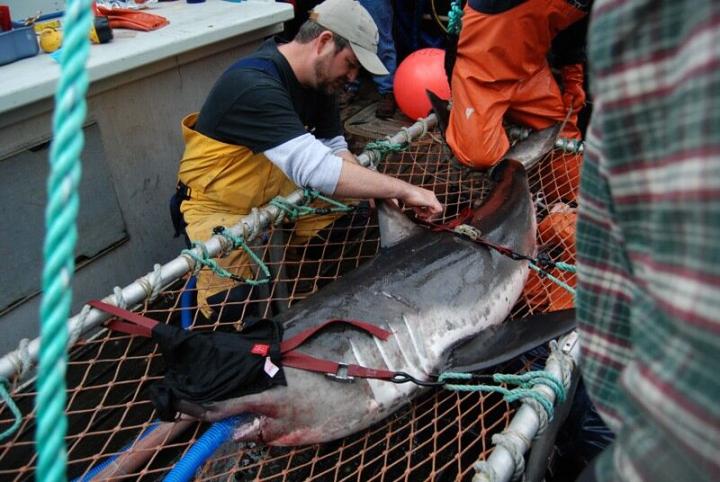New research suggests unexpected presence of great white sharks in Gulf of California

Credit: Photos courtesy of Jack Musick and Scot Anderson
Perhaps no other ocean creature lives in the human imagination like the great white shark. But while great white sharks might be plentiful in the minds of beachgoers across the country, there are only a handful of places in the world where white sharks can be consistently found. In those areas — such as Central California, Guadalupe Island Mexico, South Australia and South Africa — they tend to be found aggregated in small hotspots, often located around seal colonies.
Researchers have estimated that white shark populations are incredibly small, with only hundreds of large adults and a few thousand white sharks total in any of their global populations. This has made protecting white sharks a priority for conservation with many countries, including the United States and Mexico, having laws in place to prevent the catching and killing of the species.
After uncovering a previously unknown white shark hot spot in the central Gulf of California, however, a new study involving University of Delaware assistant professor Aaron Carlisle suggests that these low numbers for eastern north Pacific white sharks, especially those listed in the Gulf of California, might be underestimated. In addition, the researchers found that the mortality rates for these white sharks might be underestimated as well, as an illicit fishery for the species was uncovered in the Gulf of California, suggesting that fishers were killing many more white sharks than has been previously understood.
The research findings were published in Conservation Letters. Daniel J. Madigan, of the Department of Integrative Biology at the University of Windsor in Ontario, Canada, served as the lead author on the paper and Carlisle, assistant professor in UD’s School of Marine Science and Policy in the College of Earth, Ocean and Environment, served as a co-author on the paper.
Underestimated Mortality
For this study, Madigan interacted with a small group of local fishermen and over several months that group killed about 14 large white sharks. Of these, almost half could have been mature females. This was a conservative estimate as other groups reportedly killed additional sharks during this time.
To show just how significant this new source of mortality might be, Carlisle pointed to a National Oceanic and Atmospheric Administration (NOAA) endangered species act status review on white shark populations from 2012. Using the best available information at the time, the NOAA report estimated that the adult female mortality rate for the entire eastern Pacific was likely around two annually.
“He found, in just a two-week time period, more mortality in this one location than what we thought for the whole ocean,” said Carlisle. “It was pretty clear then that, well, something kind of important is happening here.”
Carlisle explained that the mortality estimate of the earlier NOAA study could have been off because calculating mortality for animals in the ocean — figuring out how many die naturally or unnaturally — is one of the most difficult population metrics to quantify.
What makes this finding particularly interesting is that this population of white sharks — the eastern Pacific population of white sharks — is perhaps the most well-studied group of sharks on the planet. Here, in the midst of all this scientific research, was a seemingly robust population of white sharks that had eluded scientific study.
“It’s been about 20 years since a new ‘population’ of white sharks has been discovered,” said Carlisle. “The fact that the eastern Pacific has so much infrastructure focused on white sharks and we didn’t know that there were these sites in the Gulf of California was kind of mind-blowing.”
Future steps
Now that the aggregation has been identified, Carlisle said that there are many more scientific questions that need to be answered.
There is a pressing need to study and quantify the population of sharks in the new aggregation site. In particular, it is unknown whether these sharks are part of the other known populations of white sharks in the eastern Pacific, which include populations that occur in Central California and Guadalupe Island Mexico, or whether they belong to a third, unknown population.
They are also interested in finding out how long the aggregation sites have been there and how long people have been fishing at the sites.
“One of the big points of this paper was to raise the red flag and let managers and scientists know that this is going on and this population is here and needs to be studied,” said Carlisle. “Hopefully, it will be studied by some local researchers who are invested and working with the local fishing communities because these fishing communities are all heavily dependent on marine resources and fisheries.”
Carlisle stressed that the researchers are not looking to cause problems for the local fishing communities that they worked with for the study.
Instead, perhaps there is an opportunity for these communities to learn about other opportunities with these animals through avenues like eco-tourism, educating them on the fact that these sharks are worth more and could provide a steadier stream of revenue alive rather than dead.
“This seems like it would be a perfect situation for ecotourism, much like there is at Guadalupe Island,” said Carlisle. “There could be huge opportunities to build businesses around these populations of sharks, and that’s just from a management point of view. From a science point of view, there’s all sorts of fun things you could do.”
Still, Carlisle said that more than anything, this paper highlights just how little we know about what is going on with sharks in the ocean.
“Even though we’ve studied these animals so much, we still know so little,” said Carlisle. “How many fish are in the ocean is a very old but very hard question to answer.”
###
Media Contact
Peter Kerwin
[email protected]
Original Source
https:/




